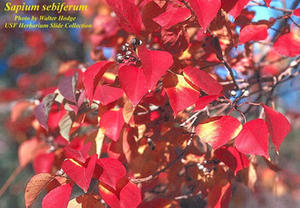With autumn fast approaching, many landowners are looking to add fall color to their landscapes. Unfortunately, many will choose tree varieties based on their fall foliage rather than the possibility of it being an invasive species. One tree that provides beautiful fall color is the Chinese Tallow tree (Sapium sebiferum (L.) also known as the Popcorn Tree.
The Chinese Tallow is a fast growing deciduous tree. It can reach heights of 30 feet and its seeds resemble popcorn, hence the colloquial name. These popcorn shaped seeds, which can be spread by animals, and the root system sprouts make it very hard to control this non-native tree. It has spread to every coastal state from North Carolina to Texas, and as far inland as Arkansas. In Florida it has been found as far south as Tampa.
The Chinese Tallow was listed in Florida as a noxious weed in 1998, which means that possession with the intent to sell, transport, or plant is illegal in the State of Florida. Unfortunately, this invasive tree is still being found in home landscapes due to its ability to reproduce rapidly, create great shade and deliver beautiful, reddish fall leaves.
So even though the Chinese tallow has great fall foliage there are too many problems that come along with it to offer a recommendation. To read more on how to control Chinese tallow check out this fact sheet from the UF IFAS Center of Aquatic and Invasive Plants.
If fall color is important, there are many native species to choose from. To learn more about non-invasive native landscape plants with fall color, check out this publication on Florida native plants. It lists the Sweetgum, a native that is capable of producing great fall color.
- Vegetable Garden Insect and Disease Management - June 10, 2015
- Insect Problems in the Heat of Summer - May 8, 2015
- Gardening in a Bucket - April 14, 2015

